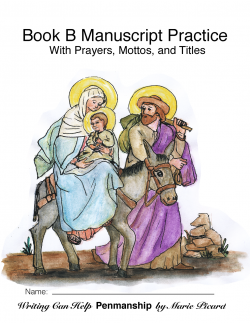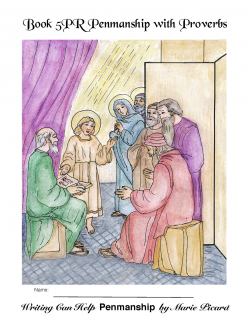
Mastering
Penmanship

Welcome to Marie’s Penmanship Books
These books are a series that teach a student to master the art of handwriting in manuscript, cursive, calligraphy, and other penmanship skills.
Contents:
- Cursive Handwriting Penmanship (Books 1-3, 5-8) uses letters, words, and Bible verse selections for practice. Each book encourages making artistic borders around one’s work to develop writing motor skills. Test sentence to see improvement at the end of each book. View the samples.
- Manuscript Printing for beginners (Books A,B,1) in Roman Style, View the samples.
- Step by Step Calligraphy in Italic, Gothic, and Uncial style. (Book 4) A flat nib pen is recommended for it.
- How to do the letters of the Versal Alphabet to begin Cursive verses as in antique holy cards. (Book 5B)
- Handwriting with Proverbs (Book 5PR) The cursive formation of the alphabet is introduced with the International Radio Alphabet. Guess the correct word to complete the Proverb practice. Answer key.
- Book 5MP Manuscript Printing. (New in 2022) Scripture verses are used for practice. Review printing.
- Book 9 is meant to sharpen legibility of manuscript block letters, upper and lower case printing.
- Two European Handwriting Styles-Simple and Traditional using Bible verse and greetings in Latin, English, French, and Spanish (Book 10). A fine or medium tipped ballpoint pen is recommended.
- Bible DVD’s, the Holy Rosary DVD, and a Way of the Cross DVD, hard copy and pdf format. CD’s too.
- Little Bird birthday calendar available in hard copy and in pdf format. Handwrite or print in the names.
- Altar Servers Study Guide for Holy Mass
- Learn to Sew booklet
Ebooks are Available! Each penmanship book is now also available as an Ebook in PDF format. Shipping Ebooks is FREE. You can get your Ebook in a matter of minutes by downloading after your purchase. Selected hard copies are available on the menu bar in SHOP – penmanship books. Ebooks are available in SHOP -Ebooks. Both can be found in “View all Products” below.
Handwriting is a talent that one can always learn and practice anytime, even as an adult. We can improve the appearance of our handwriting with diligent practice and still retain a personal style. The results of our handwriting are always a telling detail of our personality. It often happens that we need to sign a legal document or sign an application form. It is then advisable to have developed a unique signature to fit the space and only you can reproduce it and others will recognize it as your signature. It’s the exception to legible handwriting!! On this site you may view information about each book as well as download a few sample pages from each one. These books are available by secure online purchasing through paypal.com We encourage you to browse anytime. Purchasing can be done Monday thru Saturday. Please avoid Sunday purchasing to keep Sundays holy on the Lord’s Day. If you are a Canadian customer living in Canada and you have questions concerning shipping please call or email us. We hope you have a good experience in attaining good legible handwriting when using our materials.
Email: ppicard@usa.net, or phone (226 678 7305) – Marie Picard




